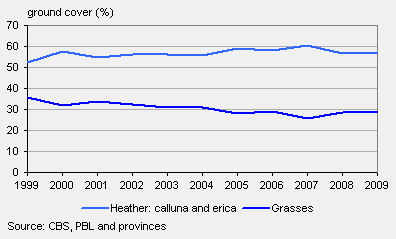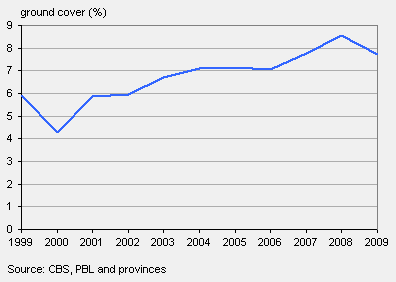Dutch heathland: more purple, less yellow

Dutch heaths have been changing colour in recent years. Plants that colour heathland purple, such as heather, have been increasing, while grasses that give heathland a more yellow colour, such as wavy hair grass, have decreased slightly. The main cause for this change is intensive heathland management.
Ground cover of grasses and two species of heather on dry heathland

Nitrogen deposits result in more grass
Deposits of nitrogen are an important factor for the increasing occurrence of grass on heathland. Certain species of grass which occur naturally on heathland then start to become dominant, such as wavy hair grass on dry heathland and purple moor grass on moist heathland. Although nitrogen deposits from the air have decreased considerably in recent years, a result of among other things stricter manure regulations and cleaner cars, for low-nutrient ecosystems like heathland and moors nitrogen levels are probably still too high to have any effect. Indeed as yet neither an increase in nitrophobe plants nor a decrease in nitrophile plants has been observed on heathland.
Ground cover trees and shrubs on dry heathland

Heath management
It takes intense management to maintain the natural state of heathland. Grazing, peat cutting and mowing are measures employed to prevent heathland being taken over by grass, trees and shrubs. The decrease in grass and the more purple colour of heathland are probably the result of these management measures.
Grazing livestock
There is still a lot of debate about the most effective way to manage heathland. Large-scale peat cutting, for example, results in more purple heather, but is not always desirable from the viewpoint of increasing biodiversity, as large part of the original varied structure is lost, alongside a number of rare plant and animal species. The use of sheep flocks comes closest to traditional use of heathland, but larger animals such as horses and cattle are also put out to graze on heathland to prevent re-colonisation by grass, trees and shrubs.
Lodewijk van Duuren, Tom van der Meij and Emma van den Dool (Province of Utrecht)